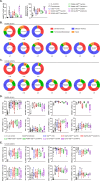Vδ2 T-cell engagers bivalent for Vδ2-TCR binding provide anti-tumor immunity and support robust Vγ9Vδ2 T-cell expansion
- PMID: 39493452
- PMCID: PMC11527600
- DOI: 10.3389/fonc.2024.1474007
Vδ2 T-cell engagers bivalent for Vδ2-TCR binding provide anti-tumor immunity and support robust Vγ9Vδ2 T-cell expansion
Abstract
Background: Vγ9Vδ2 T-cells are antitumor immune effector cells that can detect metabolic dysregulation in cancer cells through phosphoantigen-induced conformational changes in the butyrophilin (BTN) 2A1/3A1 complex. In order to clinically exploit the anticancer properties of Vγ9Vδ2 T-cells, various approaches have been studied including phosphoantigen stimulation, agonistic BTN3A-specific antibodies, adoptive transfer of expanded Vγ9Vδ2 T-cells, and more recently bispecific antibodies. While Vγ9Vδ2 T-cells constitute a sizeable population, typically making up ~1-10% of the total T cell population, lower numbers have been observed with increasing age and in the context of disease.
Methods: We evaluated whether bivalent single domain antibodies (VHHs) that link Vδ2-TCR specific VHHs with different affinities could support Vγ9Vδ2 T-cell expansion and could be incorporated in a bispecific engager format when additionally linked to a tumor antigen specific VHH.
Results: Bivalent VHHs that link a high and low affinity Vδ2-TCR specific VHH can support Vγ9Vδ2 T-cell expansion. The majority of Vγ9Vδ2 T-cells that expanded following exposure to these bivalent VHHs had an effector or central memory phenotype and expressed relatively low levels of PD-1. Bispecific engagers that incorporated the bivalent Vδ2-TCR specific VHH as well as a tumor antigen specific VHH triggered antitumor effector functions and supported expansion of Vγ9Vδ2 T-cells in vitro and in an in vivo model in NOG-hIL-15 mice.
Conclusion: By enhancing the number of Vγ9Vδ2 T-cells available to exert antitumor effector functions, these novel Vδ2-bivalent bispecific T cell engagers may promote the overall efficacy of bispecific Vγ9Vδ2 T-cell engagement, particularly in patients with relatively low levels of Vγ9Vδ2 T-cells.
Keywords: Vγ9Vδ2 T-cells; bispecific T-cell engager; cancer; expansion; immunotherapy; single domain antibody.
Copyright © 2024 King, de Jong, Veth, Lutje Hulsik, Yousefi, Iglesias-Guimarais, van Helden, de Gruijl and van der Vliet.
Conflict of interest statement
NV. TG and HV own LAVA Therapeutics NV shares. DH, PY, VI-G, PH and HV are/were employed by LAVA Therapeutics NV. TG is scientific advisor to LAVA Therapeutics NV. The authors declare that this study received funding from Lava Therapeutics NV. LK, MJ and MV were funded by LAVA Therapeutics NV.
Figures





Similar articles
-
A bispecific T cell engager recruits both type 1 NKT and Vγ9Vδ2-T cells for the treatment of CD1d-expressing hematological malignancies.Cell Rep Med. 2023 Mar 21;4(3):100961. doi: 10.1016/j.xcrm.2023.100961. Epub 2023 Mar 2. Cell Rep Med. 2023. PMID: 36868236 Free PMC article.
-
Leveraging Vγ9Vδ2 T cells against prostate cancer through a VHH-based PSMA-Vδ2 bispecific T cell engager.iScience. 2024 Oct 30;27(12):111289. doi: 10.1016/j.isci.2024.111289. eCollection 2024 Dec 20. iScience. 2024. PMID: 39628574 Free PMC article.
-
A Bispecific γδ T-cell Engager Targeting EGFR Activates a Potent Vγ9Vδ2 T cell-Mediated Immune Response against EGFR-Expressing Tumors.Cancer Immunol Res. 2023 Sep 1;11(9):1237-1252. doi: 10.1158/2326-6066.CIR-23-0189. Cancer Immunol Res. 2023. PMID: 37368791
-
Gamma Delta T-Cell Based Cancer Immunotherapy: Past-Present-Future.Front Immunol. 2022 Jun 16;13:915837. doi: 10.3389/fimmu.2022.915837. eCollection 2022. Front Immunol. 2022. PMID: 35784326 Free PMC article. Review.
-
The Vγ9Vδ2 T Cell Antigen Receptor and Butyrophilin-3 A1: Models of Interaction, the Possibility of Co-Evolution, and the Case of Dendritic Epidermal T Cells.Front Immunol. 2014 Dec 19;5:648. doi: 10.3389/fimmu.2014.00648. eCollection 2014. Front Immunol. 2014. PMID: 25566259 Free PMC article. Review.
References
-
- Melandri D, Zlatareva I, Chaleil RAG, Dart RJ, Chancellor A, Nussbaumer O, et al. . The gammadeltaTCR combines innate immunity with adaptive immunity by utilizing spatially distinct regions for agonist selection and antigen responsiveness. Nat Immunol. (2018) 19:1352–65. doi: 10.1038/s41590-018-0253-5 - DOI - PMC - PubMed
LinkOut - more resources
Full Text Sources

